O8380
1-Octanesulfonic acid sodium salt
≥98%
Synonym(s):
Octane-1-sulfonic acid sodium salt, Sodium 1-octanesulfonate, Sodium octane-1-sulfonate, Sodium octanesulfonate
About This Item
Recommended Products
biological source
synthetic (oragnic)
Quality Level
description
anionic
assay
≥98%
form
powder
mol wt
216.27 g/mol
technique(s)
HPLC: suitable
impurities
<2.0% water (Karl Fischer)
mp
300 °C (572 °F)
solubility
9.8 g/L at 20 °C
cation traces
Na: 10.1-11.1 % (w/v) (Anhydrous)
SMILES string
[Na+].CCCCCCCCS([O-])(=O)=O
InChI
1S/C8H18O3S.Na/c1-2-3-4-5-6-7-8-12(9,10)11;/h2-8H2,1H3,(H,9,10,11);/q;+1/p-1
InChI key
HRQDCDQDOPSGBR-UHFFFAOYSA-M
Looking for similar products? Visit Product Comparison Guide
General description
Application
- as a component of 9 parts buffer to determine the concentration of L-Dopa in extracts of seed flour
- in mobile phase solution to measure dopamine in rats using high-performance liquid chromatography (HPLC) analysis
- in neurochemistry for the preparation of mobile phase buffer for HPLC analysis.
Features and Benefits
- Highly versatile surfactant for your cell biology and biochemical research
- Suitable for HPLC applications
Other Notes
comparable product
signalword
Danger
hcodes
Hazard Classifications
Eye Dam. 1 - Skin Corr. 1B
Storage Class
8B - Non-combustible corrosive hazardous materials
wgk_germany
WGK 2
flash_point_f
Not applicable
flash_point_c
Not applicable
ppe
Eyeshields, Gloves, type N95 (US)
Choose from one of the most recent versions:
Already Own This Product?
Find documentation for the products that you have recently purchased in the Document Library.
Customers Also Viewed
Our team of scientists has experience in all areas of research including Life Science, Material Science, Chemical Synthesis, Chromatography, Analytical and many others.
Contact Technical Service










